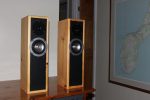They’ll run away screaming “NOOOOOOOO!” to this notion:
Canada’s plan “B” might include iBiquity.
(as reported by Inside Radio)
Let’s just hope that this is more of iBiquity’s wishful thinking, which is often presented as actual important news being based in fact. By iBiquity.
Why does the CRTC need a plan B anyway? Is it not enough that Eureka 147 failed mainly due to a lack of public interest? If it was something that was commercially viable, wouldn’t it have taken off on its own? Now they are thinking of ruining the FM broadcast band, which, in my experience in Canada, is working perfectly fine.
Who says “digital” is better? If anything, what has been discovered in this country is when it comes to HD radio, digital is worse. Thus far, HD radio has the following going for it:
- Proprietary system with expensive licensing fees
- Complicated infrastructure
- Insufficient building penetration
- Poor performance in mobile reception environments
- Lack of original programming
- Adjacent channel interference
- Poor receiver sales
- Lack of general interest and/or knowledge by the public
All of these things have been well documented. If you work for the Canadian Radio-Television and Telecommunication Commission (CRTC) and are thinking about this, contact me. I’ll even invite you down for a drive around and you can experience HD radio, in all its glory, firsthand.






I was hoping that AMHD would die a death forever soon and de-noise the AM band in ITU Region 2. If Canada follows and implements the AMHD model, look for an increased intense noise spectrum like back in the days of “Spark”. And who would be next, Mexico???? Spectral purity was a problem with the early MW5, and it was cured. Another cure is doing away with AMHD entirely, in order to save the AM band from “noise extinction”.
John, Right you are. I remember the MW1 transmitters sometimes had difficulty achieving the NRSC-1 mask. There was a mod made by Harris that had to be installed on all the modules which cured the situation. I suppose the most galling aspect of this all is we still have to make NRSC measurements and comply with the 10 kHz bandwidth restrictions even though AM HD creates 10 X the noise issues of pre-NRSC AM.
Sad really. I can’t begin articulate my disgust with the iBquity crowd for foisting such a terrible system on us.
“IBOC in the Canadian FM Radio Environment”
“Based on the evidence currently in hand, the DRCG considers that it would be risky for Canadian broadcasters to proceed at this time with an unrestricted roll-out of HD Radio services in the FM band, in the manner implemented in the US. There is no ground-swell of radio listener interest in this technology so far and the lack of inexpensive receivers, as well as unique new programming services, continues to make it difficult to market HD Radio to the public in the US. Moreover, there is no evidence that Canadian digital radio listeners are being lost to the 10% of US FM stations that have implemented HD Radio to date.”
http://tinyurl.com/ltxtkr
It seems the Canadians may have some sense, but one never knows. The problem is that Canada, Mexicao, and the US are all part of the North American Broadcasters Association (NABA). Also, I would never trust one thing Radio Ink publishes, as they are huge IBOC cheerleaders. Radio Ink was part of that Might Red Insignaia stunt, and helped to spread that false rumor started by Apple Insider concerning Apple including HD Radio directly in its products.
I strongly doubt that Canada will adopt IBOC, or any digital radio standard for the foreseeable future. The Eureka 147 debacle has probably scared off any interest by broadcasters in this technology. Some of these stations invested a lot to set up their Eureka systems and no one ever listened to them. Why would they want to repeat the same mistake with IBOC?
Also, given the adjacent-channel interference problem, it would be difficult to implement IBOC in the major markets in Canada, like Toronto, where the FM band is already pretty much saturated with local and semi-local stations.
And finally, it’s completely unnecessary. FM audio quality is fine for the large majority of listeners and most people aren’t going to bother to shell out for a marginal increase in audio quality, if there’s any improvement at all.